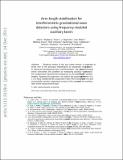| dc.contributor.author | Mullavey, Adam J. | |
| dc.contributor.author | Slagmolen, Bram J. J. | |
| dc.contributor.author | Miller, John | |
| dc.contributor.author | Sigg, Daniel | |
| dc.contributor.author | Shaddock, Daniel A. | |
| dc.contributor.author | McClelland, David E. | |
| dc.contributor.author | Waldman, Samuel J. | |
| dc.contributor.author | Evans, Matthew J | |
| dc.contributor.author | Fritschel, Peter K | |
| dc.date.accessioned | 2014-07-15T12:48:04Z | |
| dc.date.available | 2014-07-15T12:48:04Z | |
| dc.date.issued | 2011-12 | |
| dc.date.submitted | 2011-11 | |
| dc.identifier.issn | 1094-4087 | |
| dc.identifier.uri | http://hdl.handle.net/1721.1/88407 | |
| dc.description.abstract | Residual motion of the arm cavity mirrors is expected to prove one of the principal impediments to systematic lock acquisition in advanced gravitational-wave interferometers. We present a technique which overcomes this problem by employing auxiliary lasers at twice the fundamental measurement frequency to pre-stabilise the arm cavities’ lengths. Applying this approach, we reduce the apparent length noise of a 1.3 m long, independently suspended Fabry-Perot cavity to 30 pm rms and successfully transfer longitudinal control of the system from the auxiliary laser to the measurement laser. | en_US |
| dc.language.iso | en_US | |
| dc.publisher | Optical Society of America | en_US |
| dc.relation.isversionof | http://dx.doi.org/10.1364/OE.20.000081 | en_US |
| dc.rights | Creative Commons Attribution-Noncommercial-Share Alike | en_US |
| dc.rights.uri | http://creativecommons.org/licenses/by-nc-sa/4.0/ | en_US |
| dc.source | arXiv | en_US |
| dc.title | Arm-length stabilisation for interferometric gravitational-wave detectors using frequency-doubled auxiliary lasers | en_US |
| dc.type | Article | en_US |
| dc.identifier.citation | Mullavey, Adam J., Bram J. J. Slagmolen, John Miller, Matthew Evans, Peter Fritschel, Daniel Sigg, Sam J. Waldman, Daniel A. Shaddock, and David E. McClelland. “Arm-Length Stabilisation for Interferometric Gravitational-Wave Detectors Using Frequency-Doubled Auxiliary Lasers.” Optics Express 20, no. 1 (January 2, 2012): 81. | en_US |
| dc.contributor.department | Massachusetts Institute of Technology. Department of Physics | en_US |
| dc.contributor.department | MIT Kavli Institute for Astrophysics and Space Research | en_US |
| dc.contributor.mitauthor | Evans, Matthew J. | en_US |
| dc.contributor.mitauthor | Fritschel, Peter K. | en_US |
| dc.contributor.mitauthor | Waldman, Sam J. | en_US |
| dc.relation.journal | Optics Express | en_US |
| dc.eprint.version | Author's final manuscript | en_US |
| dc.type.uri | http://purl.org/eprint/type/JournalArticle | en_US |
| eprint.status | http://purl.org/eprint/status/PeerReviewed | en_US |
| dspace.orderedauthors | Mullavey, Adam J.; Slagmolen, Bram J. J.; Miller, John; Evans, Matthew; Fritschel, Peter; Sigg, Daniel; Waldman, Sam J.; Shaddock, Daniel A.; McClelland, David E. | en_US |
| dc.identifier.orcid | https://orcid.org/0000-0001-8459-4499 | |
| dc.identifier.orcid | https://orcid.org/0000-0003-1983-3187 | |
| mit.license | OPEN_ACCESS_POLICY | en_US |
| mit.metadata.status | Complete | |
